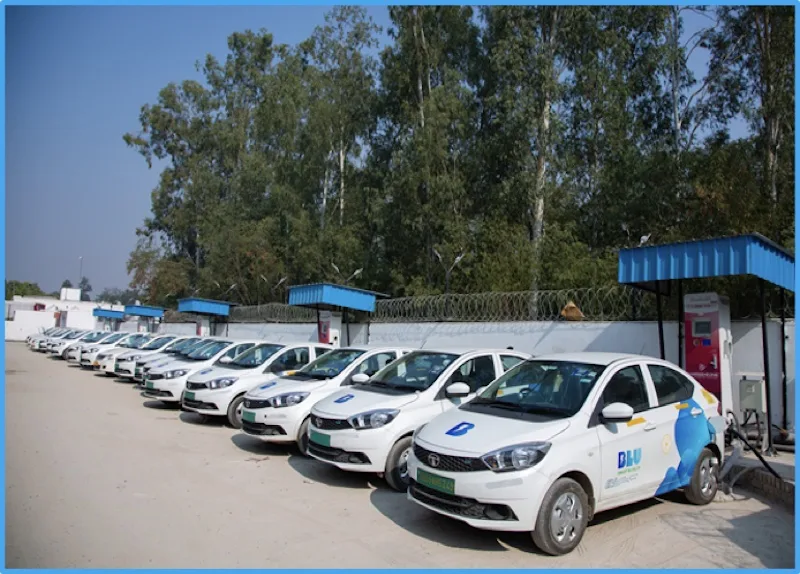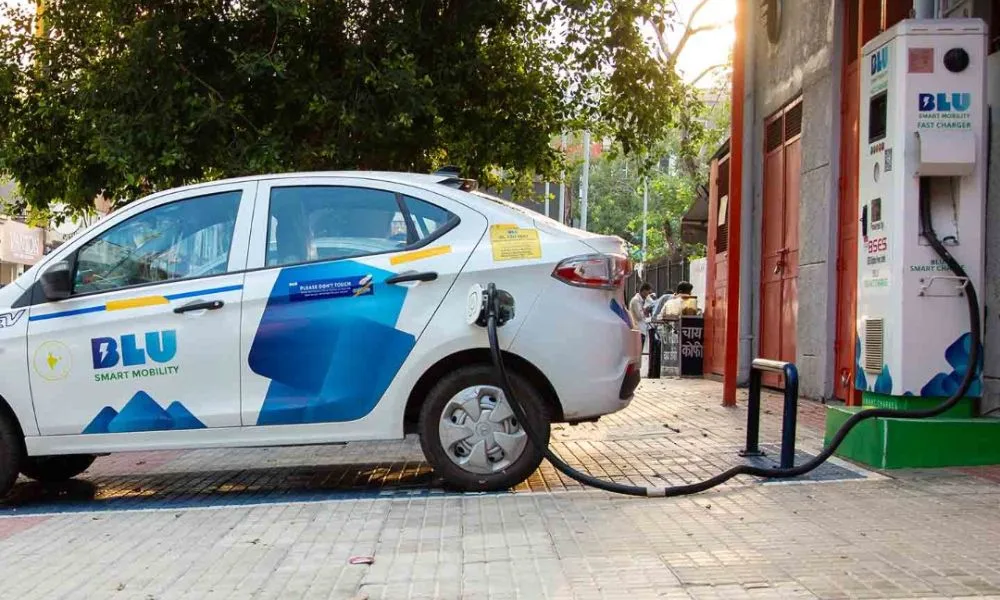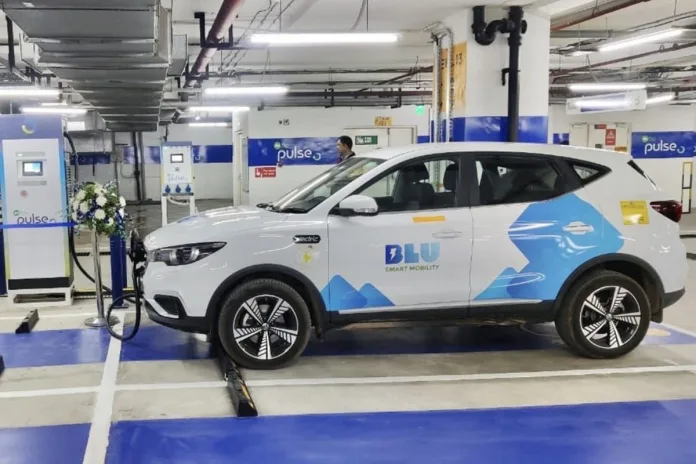BluSmart faces a major crisis with executive departures and financial challenges. Discover what’s happening with India’s pioneering EV ride-hailing company and what it means for the industry.
Table of Contents
BluSmart Executive Exodus: Key Leaders Depart Amid Restructuring

The corridors at BluSmart headquarters have grown quieter in recent weeks. What was once a bustling hub of innovation in India’s electric mobility space now faces an uncertain future as several top executives, including the CEO and CTO, have headed for the exit.
“It’s like watching a promising startup hit turbulence mid-flight,” says Rahul Sharma, an industry analyst who has followed BluSmart since its inception. “The departure of key leadership creates a vacuum at a critical time when the company needs steady hands at the wheel.”
The operations head has reportedly taken over the reins, but questions linger about whether this leadership shuffle will stabilize the company or signal more trouble ahead. For employees who joined BluSmart with dreams of revolutionizing India’s transportation landscape with zero-emission vehicles, the mood has shifted from excitement to concern.
Priya Mehta, a former BluSmart employee who recently left the company, shared her perspective: “There was such energy when I joined. We believed we were changing how India moves. But in recent months, the atmosphere changed. You could feel the tension in virtual meetings.”
Blu Smart Mobility’s Financial Challenges and Asset Sales
Behind the executive departures lies a more fundamental issue – BluSmart’s financial health appears to be deteriorating. Industry insiders report that Blu Smart Mobility is considering selling off assets to generate much-needed cash flow, a classic sign of a company in distress.
The company, which operates a fleet of electric vehicles across select Indian cities, built its business model on the promise of clean, reliable transportation. However, scaling an EV fleet requires substantial capital investment, and the road to profitability has proven longer than anticipated.
Financial data reveals the company has been burning through cash reserves while struggling to achieve the operational efficiency needed to turn a profit. The high costs of vehicle acquisition, charging infrastructure, and driver incentives have created a challenging equation that BluSmart has yet to solve.
| Financial Challenge | Impact on BluSmart | Industry Norm |
|---|---|---|
| Vehicle Acquisition Costs | High initial investment | Significant barrier for EV fleets |
| Charging Infrastructure | Requires dedicated facilities | Developing but incomplete |
| Driver Incentives | Necessary to maintain service | Common across ride-hailing |
| Operational Efficiency | Below target metrics | Critical for profitability |
| Cash Burn Rate | Accelerating | Concerning for investors |
BluSmart Cab Services Continue Despite Company Troubles
Despite the internal turmoil, BluSmart cab services continue to operate in cities like Delhi NCR and Bangalore. Customers who open the BluSmart app still see available cars and can book rides as usual, though some users report noticing fewer vehicles available during peak hours.
“I’ve been using BluSmart cab services for over a year now because I appreciate their zero-emission approach and fixed pricing,” says Vikram Desai, a regular customer in Gurgaon. “Recently, I’ve had to wait longer for rides, but the service quality remains good when I do get a car.”
The company has maintained its commitment to several key features that differentiated BluSmart cab services from conventional ride-hailing options:
- Zero-emission electric vehicles
- Professional, uniformed drivers
- Fixed pricing with no surge charges
- Scheduled booking options
- In-app safety features
However, maintaining service quality while addressing financial challenges creates a delicate balancing act for the operations team now leading the company.
BluSmart Share Price Impact: Investor Concerns Growing
For investors who backed BluSmart’s vision of transforming urban mobility, recent developments have raised serious concerns. While BluSmart is not publicly listed, the valuation metrics used in private funding rounds would likely show significant pressure on BluSmart share price equivalents.
“The recent developments have put significant pressure on BluSmart share price performance,” notes financial analyst Deepak Gupta. “Early investors are likely reassessing their positions and future funding rounds will face increased scrutiny.”
The company had previously secured funding from notable investors who believed in the potential of electric mobility in India. However, the path from promising startup to profitable enterprise has proven more challenging than anticipated.
EV Companies in India Share Price Comparison: How BluSmart Stacks Up

When comparing EV companies in India share price trends, BluSmart’s situation highlights broader challenges in the sector. While public companies like Tata Motors have seen their EV divisions gain traction, smaller pure-play EV startups face significant hurdles.
| Company | Business Model | Current Market Position | Investor Sentiment |
|---|---|---|---|
| BluSmart | EV ride-hailing | Facing significant challenges | Increasingly cautious |
| Ola Electric | EV manufacturing & ride-hailing | Mixed results, strong scooter sales | Cautiously optimistic |
| Tata Motors EV | EV manufacturing | Market leader in passenger EVs | Positive |
| MG Motor India | EV manufacturing | Growing presence | Stable |
| Mahindra Electric | EV manufacturing | Expanding lineup | Improving |
The volatility seen in EV companies in India share price charts reflects the sector’s ongoing maturation. Companies that can achieve operational efficiency while managing capital requirements are better positioned to weather current market conditions.
EV Ride-Hailing India: Market Landscape and Competition
The EV ride-hailing India market continues to attract interest despite BluSmart’s challenges. The sector sits at the intersection of two major trends – the shift toward electric mobility and the growing demand for convenient transportation options.
Major players in the EV ride-hailing India sector include:
- Uber: Recently announced plans to deploy 300 BluSmart electric cabs on its platform, raising questions about a potential acquisition
- Ola: Aggressively expanding its EV fleet while also manufacturing electric scooters
- Rapido: Building presence in the electric two-wheeler ride-hailing space
- Traditional taxi operators: Gradually electrifying their fleets
“The EV ride-hailing market in India is still in its early stages,” explains transportation economist Dr. Anjali Rao. “BluSmart was an early mover, but that comes with both advantages and challenges. The fundamental market opportunity remains strong for companies that can optimize their operational model.”
BluSmart Restructuring: What Changes Are Being Implemented
In response to mounting challenges, BluSmart has initiated a restructuring process aimed at streamlining operations and reducing costs. While specific details remain closely guarded, industry sources suggest the changes include:
- Optimizing fleet deployment to focus on high-demand routes
- Renegotiating vehicle leasing arrangements
- Reducing administrative overhead
- Exploring additional revenue streams beyond direct ride-hailing
- Potentially downsizing operations in certain markets
The success of these restructuring efforts will likely determine whether BluSmart can regain its footing or if more drastic measures will be necessary.
BluSmart Uber Acquisition Rumors: Potential Industry Shakeup
Perhaps the most intriguing development in the BluSmart story is the emergence of acquisition rumors, with Uber frequently mentioned as a potential suitor. Uber’s recent decision to deploy 300 BluSmart vehicles on its platform has fueled speculation about deeper integration.
“An acquisition by Uber would make strategic sense,” says merger and acquisition specialist Arjun Kapoor. “Uber gains an established EV fleet and BluSmart’s technology, while BluSmart gets the backing of a global transportation giant with deep pockets.”
For Uber, which has committed to electrifying its fleet globally, acquiring BluSmart could accelerate its EV transition in the important Indian market. For BluSmart, becoming part of Uber might provide the financial stability and operational expertise needed to realize its vision, albeit under a different corporate umbrella.

The Road Ahead: Can BluSmart Navigate Through the Storm?
The BluSmart crisis comes at a time when the broader EV sector in India is experiencing rapid growth, making the company’s struggles particularly noteworthy. Government incentives, increasing consumer acceptance, and falling battery costs are creating favorable conditions for EV adoption.
For BluSmart, the coming months will be critical. The company must address its immediate financial challenges while articulating a convincing path to profitability. Investors will be watching closely for signs that the restructuring efforts are yielding results.
Industry experts remain divided on BluSmart’s prospects. Some see the current troubles as growing pains typical of innovative startups disrupting established industries. Others question whether the company’s business model is fundamentally viable given the capital-intensive nature of building and maintaining an EV fleet.
What’s clear is that the outcome of BluSmart’s crisis will have implications beyond one company. It will provide valuable lessons about the challenges and opportunities in India’s evolving electric mobility landscape.


